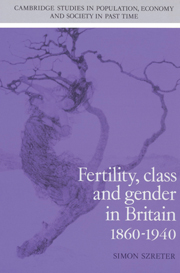Book contents
- Frontmatter
- Contents
- List of figures
- List of tables
- Acknowledgements
- List of abbreviations
- Introduction
- Part I Historiographical introduction: a genealogy of approaches
- Part II The professional model of social classes: an intellectual history
- Part III A new analysis of the 1911 census occupational fertility data
- Part IV Conceptions and refutations
- Appendices
- Bibliography
- Index
- Cambridge Studies in Population, Economy and Society in the Past Time
Introduction
Published online by Cambridge University Press: 16 February 2010
- Frontmatter
- Contents
- List of figures
- List of tables
- Acknowledgements
- List of abbreviations
- Introduction
- Part I Historiographical introduction: a genealogy of approaches
- Part II The professional model of social classes: an intellectual history
- Part III A new analysis of the 1911 census occupational fertility data
- Part IV Conceptions and refutations
- Appendices
- Bibliography
- Index
- Cambridge Studies in Population, Economy and Society in the Past Time
Summary
The period 1860–1940 witnessed a dramatic fall in fertility in British society. There was a marked decline in the number of live births experienced by each married woman in the population from an average of nearly six to an average of just over two. Fertility, class and gender in Britain, 1860–1940 is intended as a contribution to the collective effort of trying to explain and to understand how and why this happened.
By the early twentieth century there was widespread international recognition by officials and social scientists that this phenomenon had occurred in many of the economically advanced countries of the world. In fact it is now clear that both within Austro-Hungary and France there had been a substantial reduction in the birth rate in certain rural quarters from the late eighteenth century, while some aristocratic and urban bourgeois groups display reduced marital fertility in the previous century. Despite the somewhat rudimentary facilities for demographic observation possessed by most nineteenth-century states, awareness of these developments had prompted a certain amount of speculative discussion. This was particularly so in France after the disaster of the Franco-Prussian War, where the menace of her demographically more vigorous neighbour, the newly unified German Empire of Blut und Eisen, gave particular impetus to such concerns.
- Type
- Chapter
- Information
- Publisher: Cambridge University PressPrint publication year: 1996



